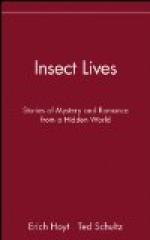With most insects, however, the larva must be regarded as the more specially modified, even if degraded, stage. Miall (1895) has pointed out that the insect grub is not a precociously hatched embryo, like the larvae of multitudes of marine animals, but that it exhibits in a modified form the essential characters of the adult. Comparison for example can be readily made between the parts of the caterpillar and the butterfly, whose story was sketched in the first chapter of this book, widely different though caterpillar and butterfly may appear at a superficial glance. And the survey of variety in form, food, and habit of insect larvae given in Chapter VI enforces surely the conclusion that the larva is eminently plastic, adaptable, capable of changing so as to suit the most diverse surroundings. In a most suggestive recent discussion on the transformation of insects P. Deegener (1909) has claimed that the larva must be regarded as the more modified stage, because while all the adult’s structures are represented in the larva, even if only as imaginal buds, there are commonly present in the larva special adaptive organs not found in the imago, for example the pro-legs of caterpillars or the skin-gills of midge-grubs. The correspondence of parts in butterfly and caterpillar just referred to, may still be traced, though less easily, in bluebottle and maggot. The latter is an extreme example of degenerative evolution, and its contrast with the elaborately organised two-winged fly marks the greatest divergence observable between the larva and imago. With this divergence the resting pupal stage, during which more or less dissolution and reconstruction of organs goes on, becomes a necessity, and it has already been pointed out how the amount of this reconstruction is greatest where the divergence between the larval and perfect stages is most marked. Whatever differences of opinion may prevail on points of detail, the general explanation of insect metamorphosis as the result of divergent evolution in the two active stages of the life-story must assuredly be accepted. No other explanation accords with the increasing degree of divergence to be observed as we pass from the lower to the higher insect orders.
The successive incidents of the life-story of most insects are largely connected with the acquisition of wings. Wings, and the power of flight wherewith they endow their possessors, are evidently beneficial to the race in giving power of extending the range during the breeding period and thus ensuring a wide distribution of the eggs. In no case are wings fully developed until the closing stage of the insect’s life, they are always acquired after hatching or birth. We have already noticed (p. 40) how Sharp (1899) has laid stress on the essential difference between the exopterygote and endopterygote insects, the wing-rudiments of the former growing outwards throughout life while those of the latter remain hidden until the pupal instar. Sharp considers that there is some difficulty




